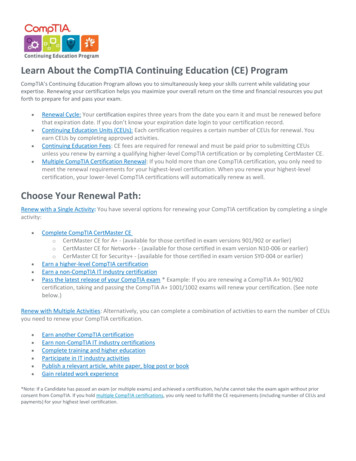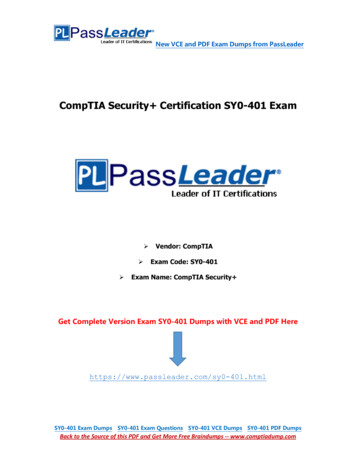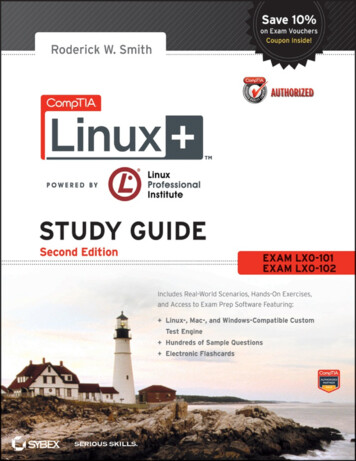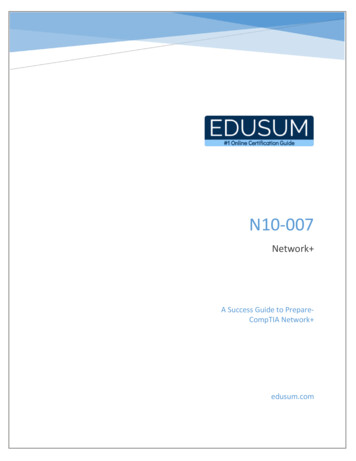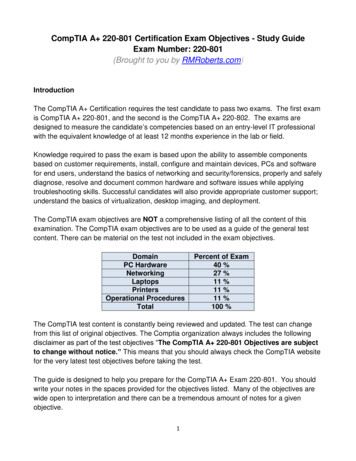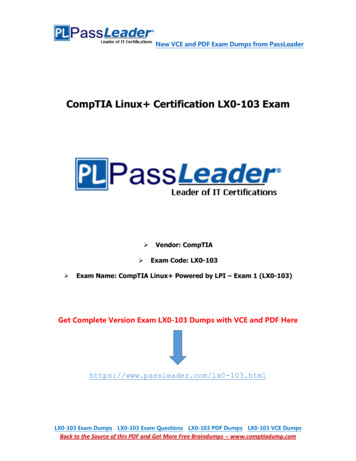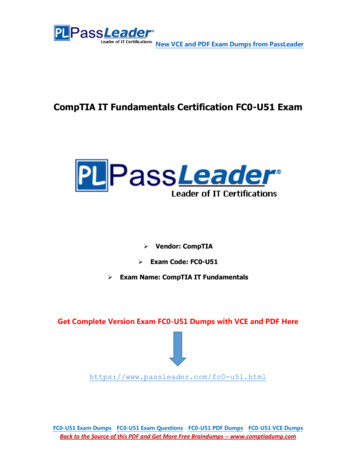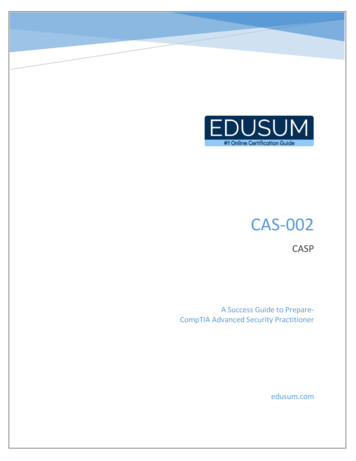
Transcription
Continue
Comptia linux study guide exam xk0- 004Christine Bresnahan (Author) Richard Blum (Author) Guide to study bestselling completely updated for NEW CompTIA Linux Exam XK0-004 This is your one-stop resource for full coverage of the XK0-004 exam, which covers 100% of all exam goals. You'll be preparing smarter and faster with Sybex for the exam,thanks to top-notch content, including assessment tests that check exam readiness, objective map, real-world scenarios, hand exercises, key exam topics and challenging questions for chapter review. Linux is a UNIX-based operating system originally created by Linus Torvalds with the help of developers around the
world. According to GNU General Public License, the source code is free of charge. Thanks to this Linux, many organizations and companies see it as an excellent, low-cost, safe alternative to expensive OS such as Microsoft Windows. The CompTIA Linux exam tests the understanding and knowledge of the Linuxkernel. As the market share of linux server continues to grow, so too does the demand for qualified and certified Linux administrators. This book will provide 100% coverage of the goals of linux exam XK0-004 based on the popular Sybex Study Guide. The book contains clear and concise information on all topics of theLinux administration and includes practical examples and insights from real-world experience. Hardware and system configuration systems Operation and maintenance Security Linux Troubleshooting and Diagnostics Automation and Scripting You will also have access to online test banks, including bonus practice exam,electronic flashcards, and searched PDF key terms. Price 60.00 Publisher Sybex Release date July 18, 2019 Pages 928 Dimensions 7.4 X 1.9 X 9.2 inches The 3.5 Language English Type Paperback EAN/UPC 9781119556039 CHRISTINE BRESNAHAN, LINUX , started working with computers more than 30 yearsago as a system administrator. He is an adjunct professor at Ivy Tech Community College, where he teaches Linux Essentials, CompTIA Linux certification and Python classes. RICHARD BLUM, LINUX , is a 30-year veteran of the IT industry as a systems and network administrator for UNIX, Linux and Microsoftservers. Rich is widely posted on Linux and open source software and is a Web Linux instructor for universities across the country. List of favorite staff (10 BOOKS) Content : Content: Introduction xxix Assessment Test xlii Part I Collection of your tools 1 Chapter 1 Preparing your environment 3 Setting up the learningspace 4 Exploring Linux distributions 8 Search terminal 14 Summary 14 Chapter 2 Overflowing services 15 What is Linux Server? 16 Serving the Basics 19 Serving Local Networks 24 Implementing Security 29 Performance Improvement 32 Summary 33 Exam Essential 34 Review Questions 35 Chapter 3 Manage files,directories and texts 39 Handling files and directories 40 Linking files and directories 55 Reading files 59 Search for information 66 Summary 77 Exam 77 Pregled Vprašanja 78 Poglavje 4 Iskanje in analiziranje besedila 83 Obdelava besedilnih datotek 84 Preusmerjanje vhoda in izhoda 95 Urejanje besedilnih datotek 105Povzetek 116 Izpit Bistvenega pomena 117 Pregled Vprašanja 118 Del II Zagon in konfiguracija vašega sistema 123 Poglavje 5 Razloži ing the Boot Process 125 The Linux Boot Process 126 The Firmware Startup 128 Linux Bootloaders 130 System Recovery 137 Summary 141 Exam Essentials 141 Review Questions143 Chapter 6 Maintaining System Startup and Services 147 Looking at init 148 Managing systemd Systems 149 Manag SysV init Systems 167 Kopanje deeper into systemd 176 Summary 179 Exam Essentials 179 Review Questions 181 Chapter 7 Konfiguriranje mrežnih veze 187 Konfiguriranje mrežnih funkcija 188Osnovno mrežno odpravljanje težav 201 Napredno mrežno odpravljanje 205 SumAry 209 Exam Essentials 210 Review Questions 212 Chapter 8 Comparing GUIs 217 Focusing on the GUI 218 Serving Up the GUI 231 Using Remote Desktops 235 Forwarding 240 Summary 245 Exam Essentials 245 Review Questions247 Poglavje 9 Prilagajanje možnosti lokalizacije 253 Razumevanje Lokalizacija 254 Nastavitev vašega lokala 256 Ogled časa 259 Povzetek 265 Izpit Bistvenega pomena 266 Pregled Vprašanja 267 Del III Upravljanje vašega sistema 273 Poglavje 10 Upravljanje uporabnikov in skupin 275 Upravljanje uporabniškihračunov 276 Upravljanje skupin 294 Nastavitev Up the Environment 297 Querying Users 300 Upravljanje uporabom prostora na disku 304 Rezime 308 Exam Essentials 308 Review Questions 310 Chapter 11 Handling Storage 315 Storage Basics 316 Partitioning Tools 318 Understanding Filesystems 323 FormatingFilesystems 326 Mounting Files Sistemi 329 Upravljanje datotekama sistemi 331 Storage Alternatives 333 Pregled 338 Exam Essentials 338 Review Questions 340 Chapter 12 Protecting Files 343 Understanding Backup Types 344 Looking at Compression Methods 346 Comparing Archive and Restore Utilities 349Securing Offsite/Off -System Backups 362 Checking Backup Integrity 366 Summary 368 Exam Essentials 368 Review Questions 370 Chapter 13 Governing Software 373 Working with Source Code 374 Packaging Applications 380 Summary 392 Exam Essentials 393 Review Questions 394 Chapter 14 Naveza namodule jedra 397 Raziskovanje jedrnih modulov 398 Namestitev jedrnih modulov 402 Odstranjevanje jedrnih modulov 404 Povzetek 405 Izpit Bistvenega pomena 405 Pregled Vprašanja 407 Del IV Zagotavljanje vašega sistema 4 409 Chapter 15 Applying Ownership and Permissions 411 Looking at File and DirectoryPermissions 412 Access Control Lists 420 Context-Based Permissions 422 Understanding Linux User Types 430 Restricting Users 431 Summary 435 Exam Essentials 436 PregledNastavna vprašanja 437 Poglavje 16 Gledati metode dostopa i avtentikacije 439 Učiti PAM 440 Exploring PKI Concepts 452 Using SSH 455Using VPN as a Client 468 Summary 469 Exam Essential 469 Review Questions 471 Chapter 17 Implementing Logging Services 473 Understanding The Importance of 474 Basic Logging Using rsyslog 477 Journaling with systemd-journald 480 Summary 483 Exam Essentials 484 484 Questions 485 Chapter 18 ControlLinux Firewalls 487 Providing Access Control 488 View Firewall Technologies 490 Forwarding IP Packets 505 Dynamic setting Rules 506 Summary 508 Exam Essential 508 Review Questions 510 Chapter 19 Embrace best security practices 5 13 User Security 514 System Security 518 Network Security 525 Summary528 Exam Essentials 528 Review Questions 530 Part In Troubleshooting Your System 533 Chapter 20 Analysing System Properties and Remediation 535 Troubleshooting the Network 536 Troubleshooting Storage Issues 549 Troubleshooting CPU 554 Troubleshooting Memory 556 Survival lost root Password 560Summary 562 Exam Essential 562 Overview Questions 563 Chapter 21 Optimization Performance 567 Process viewing 568 Real-time monitoring processes 570 Process management 573 Summary Exams Essentials 577 Review Questions 579 Chapter 22 Investigating User Issues 581 Troubleshooting Access 582Examining File Obstacles 588 Exploring Environment and Shell Issues 591 Exam Essentials 593 Review Questions 594 Chapter 23 Dealing with Linux Devices 597 Communicating with Linux 598 Devices Working with devices 605 Using warm-on devices 613 Summary 615 Exam Essential 616 Overview Questions 617Chapter 24 Troubleshooting Use and hardware problems 619 Handling storage problems 620 Detection of application permissions Issues dedicated to Analysis of Applications Dependencies 628 Looking at SELinux Context Violations 633 Exploring Firewall Blockages 633 Troubleshooting Additional Hardware Issues635 Summary 643 Exam Essentials 643 Review Questions 645 Part VI Automating Your System 649 Chapter 25 Deploying Bash Scripts 651 The Basics Shell Scripting 652 Advanced Shell Scripting 657 Writing Script programs 663 Summary 673 Exam Essential 674 Review Questions 675 Chapter 26 Job Automation677 Running scripts in background mode 678 Running scripts without console 6 Sending Signals 681 Transaction Control 683 Running Like Clockwork 687 Summary Summary 692 Exam Essentials 693 Review Questions 694 Chapter 27 Controlling Versions with Git 697 Understanding Version Control 698 Setting UpYour Environment Git 700 Committing with Git 703 Merging Versions 710 Summary 713 Exam Essentials 713 Review Questions 715 Part VII Delivering virtual and cloud environments 717 Chapter 28 Understanding cloud concepts and virtualization 719 Adherence to cloud services 720 Understanding virtualization 723Container exploration 727 Drill 729 Summary 730 Exam Essential 731 Review Questions 732 Chapter 29 Review cloud and Virtualization Services 735 Focusing on VM Tools 736 Understanding Bootstrapping 740 Exploring Storage Issues 746 Network Considering Configurations 747 Summary Summary 750 ExamEssentials 751 Review Questions 752 Chapter 30 Orchestrating the Environment 755 Understanding Orchestration Concepts 756 Providing Data Center 760 Viewing Orchestration Engines 763 Summary 765 Exam Essential 765 Review Questions 766 766 Answers to question 769 Overview Chapter 2: Service streams770 Chapter 3: Manage files, names, I Text 773 Chapter 4: Repositioning and analyzing text 777 Chapter 5: Amplating the start-up process 781 Chapter 6: System Maintenance Starting services 784 Chapter 7: Configuring network connections Chapter 7 88: Subject GUI 791 Chapter 9: Configuring localisation options795 Chapter 10: User Management and Groups 798 Chapter 11: Storage Management 801 Chapter 12: Protecting Files 803 Chapter 13: Managing Software 804 Chapter 14: Teding Kernel Modules 806 Chapter 15: Applying Ownership and Permissions 808 Chapter 16: Looking at Access and Methods overe 810Chapter 17: Implementing logging services 811 Chapter 18: Controlling Linux firewalls 813 Chapter 19: Approating best practice 815 Chapter 20 : Embrace of best security practices 817 Chapter 21: Optimizing performance 818 Chapter 22: Investigating user issues 820 Chapter 23: Dealing with Linux devices 822Chapter 24: Troubleshooting Uses and hardware Issues 824 Chapter 25: Deploying Bash Scripts 826 Chapter 26: Automating Jobs 827 Chapter 27: Controlling Versions with Git 829 Chapter 28: Understanding Cloud and Virtualization Concepts 3 831 Chapter 29: Overview of cloud and virtualization Services 832Chapter 30: Orchestrating the Surrounding 834 Index 837 Citation preview CompTIA Linux Study Guide Exam XK0-0 Fourth Edition CompTIA Linux Study Guide Exam XK0-004 Fourth Edition Christine Bresnahan Richard Blum Senior Acquisitions Editor: Kenyon Brown Development Editor: Stephanie BartonTechnical Editor: David Clinton, Jason Eckert, I Kevin E. Ryan Production Editor: Lauren Freestone Copy Editor : Judy Flynn Editorial Manager : Pete Gaughan Production Manager: Kathleen Wisor Associate Publisher: Jim Minatel Proofreader: Kim Wimpsett Indexer: Johnna VanHoose Dinse Project Coordinator, Cover:Brent Savage Cover Designer: Wiley Cover Image: Getty Images, Inc./Jeremy Woodhouse Copyright 2019 by John Wiley & Sons, Inc., Indianapolis, Indiana Published simultaneously in Canada ISBN: 978-1-119-55603-9 ISBN: 978-1-119-55605-3 (ebk.) ISBN: 978-1-119-55604-6 (ebk.) Manufactured in the UnitedStates No part of this publication may be reproduced, stored in a system for the acquisition or transfer in any form or by any means, electronically, mechanically, photocopying, recording, scanning or otherwise, unless permitted under Sections 107 or 108 of the United States Copyright Act of 1976 – This was written inwriting to publisher nor the no-go-to copy, at 222 Rosewood Drive, Danvers, MA 01923, (978) 750-8400, fax (978) 646-8600. Requests to the publisher for permission should be addressed to the 2011 Department of Permission, John Wiley & Sons, Inc., 111 River Street, Hoboken, NJ 07030, (201) 748-6011, fax(201) 748-6008, or online online Limit Restriction Warranties: the issuer and the author make no representations or warranties regarding the accuracy or completeness of the content of this Work and specifically refuse all warranties, including without limitation of warranty of suitability for a particular purpose. Sales orpromotional materials cannot create or renew the warranty. The advice and strategies in this case may not be appropriate for any situation. This work is sold with the understanding that the issuer does not provide legal, accounting or other professional services. If professional assistance is required, the services of thecompetent professional person must be sought. Neither the issuer nor the author can be entitled to the resulting compensation. The fact that an organization or website is listed in this Section as a citation and/or potential source of additional information does not mean that the author or publisher supports information thatthe organization or website may submit or recommendations that it may make. In addition, readers should be aware that the Internet sites listed in this section may have changed or disappeared while this work was written and when it was read. For general information about our other products and services or to obtaintechnical support, please contact our Customer Care Unit within the United States at (877) 762-2974, outside the U.S. at (317) 572-3993 or fax (317) 572-4002. Wiley publishes in various printed and electronic formats and after printing on demand. Certain materials included in standard printed versions of this book maynot be included in e-books or in on-demand printing. If this book applies to media, such as a CD or DVD, that is not included in the version you purchased, you can download this material to . For more information about Wiley products, visit www.wiley.com. Library of Congress Control Numbers: 2019940123TRADEMARKS: Wiley, wiley logo and Sybex logo are trademarks or registered trademarks of John Wiley & Sons, Inc. and/or its subsidiaries, in the United States and other countries, and may not be used without written permission. CompTIA is a registered trademark of computing technology industry association,Inc. All other trademarks are the property of their respective owners. John Wiley & Sons, Inc. is not related to any of the products or sellers mentioned in this book. 10 9 8 7 6 5 4 3 2 1 Confessions First, all glory and praise go to God, who through his Son, Jesus Christ, makes all possible and gives us the gift of perennight life. Many thanks go to a fantastic team of people in Sybex for their excellent work on this project. Thanks to Kenyon Brown, the senior takeover editor who offered us the opportunity to work on this book. Thanks to Stephanie Barton, the development editor who kept things on the way and made the book morepresented. Thank you, Steph, for all your hard work and diligence. Technical lecs, Kevin E. Ryan and Eckert, did a wonderful job double-checking all the work in the book in addition to making suggestions for improving content. He also hinged with David B. Clinton for taking over the reins as technical editor near theproject and offering his wonderful advice. Thanks also to the young and talented Daniel Anez (theanez.com) for the illustration. We also thank Carole Reindeer at Waterside Productions, Inc., for this opportunity for us and for helping with her writing career. Christine would particularly like to thank her husband Timothy forhis encouragement, patience and willingness to listen, even when she has no idea what he is talking about. Christine would also like to express her love for Samantha and Cameron: May God bless your marriage richly. Rich would especially like to thank his wife Barbara for withstanding her whimsical relationship duringthis project and helping to preserve spirits with baked goods. About authors Christine Bresnahan, CompTIA Linux , LPIC-1, started working with computers more than 30 years ago in the IT industry as a system administrator. Christine is an adjunct professor at Ivy Tech Community College, where she teaches Linuxcertification and Python programming classes. He also writes books and makes instruction instructions. Richard Blum, CompTIA Linux ce, CompTIA Security ce, LPIC-1, has worked in the IT industry for more than 30 years as a system and network administrator, and has published numerous Linux and open sourcebooks. Rich is an online instructor for Linux and online programming courses used by colleges and universities throughout the United States. When he's not a computer nerd, Rich enjoys spending time with his wife Barbara and his two daughters, Katie and Jessica. Content at first sight Introduction Xxix Assessment Testxlii Part I Collection of your tools 1 Chapter 1 Preparing your environment 3 Chapter 2 Seeding by services 15 Chapter 3 File management, Imenici i text 39. Options 253 Part Iii Managing your system 273 Chapter 10 User and group management 275 Chapter 11 Handling Storage 315 Chapter 12 File protection 343Chapter 13 Software management 373 Chapter 14 Attachment of core modules 397 Part IV Ensuring your System Chapter 15 Use ownership and permissions 41 Chapter 16 Looking at Access and Authentication Methods 439 Chapter 17 Implementing Logging Services 473 Chapter 18 Overseeing Linux Firewalls 487Chapter 19 Embracing Best Security Practices 513 123 409 xii Contents to the part view V system troubleshooting 533 Chapter 20 Analyzing system properties and 535 Chapter 21 Performance optimization 567 Chapter 22 Investigating user issues 581 Chapter 23 Addressing Linux devices 597 Chapter 24Troubleshooting Use and hardware problems 619 Part VI Automating your system Chapter 25 Deployment bash scripts 651 Chapter 651 Chapter 26 Automatization jobs 67 Chapter 27 Controlling Versions with Git 697 Part VII Realizing Virtual and Cloud Environments Chapter 28 Understanding Cloud and VirtualizationConcepts 719 Chapter 29 Inspecting Cloud and Virtualization Services 735 Chapter 30 Orchestrating The Environment 755 Appendix Answers to Review Questions 769 649 717 Index 837 Content Introduction xxix Assessment Test Part I Chapter 1 xlii Tool collection 1 Preparing your environment 3 Setting up thelearning space 4 Using this old laptop 4 Creating virtual 5 Jumping u Cloud 7 Exploring Linux Distributions 8 Looking at CentOS 9 Looking at Ubuntu 10 Looking at openSUSE 12 Looking at Fedora 13 Locating a Terminal 14 Summary 14 Chapter 2 Sifting Through Services 15 What is a linux server? 16 Startup Services17 Customer Listening 18 Serve Basics 19 Web Servers 20 Database Servers 21 Mail Servers 22 Serve Local Networks 24 File Servers 25 Printing Servers 26 26 Network Resources Servers Implementing Security 29 Authentication Server 29 Certificate Authority 30 Access Server (SSH) 31 Virtual Private Networks 3132 Proxy Server Monitoring 32 Xiv Contents Improving Performance 32 Clustering 32 Load Balancing 33 Containers 33 Exam Essentials 34 Review Questions 35 Chapter 3 Managing Files, names, i text 39 40 rupee files i direktorijima Review i legalized file 40 Copy i ming file 45 Removing file 52 Linking Files andDirectories 55 Establishing a Hard Link 55 Constructing a Soft Link 57 5 9 Reading Files Reading Entire Text Files 55 Establishing a Hard Link 55 Constructing a Soft Link 57 59 Reading Files Reading Entire Text Files 5 59 61 Reading Text File Portions Reading Text File Pages 65 Finding Information 66 Exploring FileDifferences 67 Using Simple Pinpoint Commands 69 Using Intricate Pinpoint Commands 73 Summary 77 Exam Essentials 77 78 Review Questions Chapter 4 Search and Analyze Text 83 Processing Text Files Filtering Text Formatting Text Determination Word Count Redirection Input and Output Handling StandardOutput processing Redirect Standard error Edit standard input pipeline commands Create here Documents Create command lines Edit text files Valuation Text editors Learning about stream editors 84 84 89 93 95 95 96 98 100 102 103 105 105 110 Contents xv Summary 116 Exam Essentials 117 Review Questions 118Part II Chapter 5 Starting Up i Configuring your system 123 Explanation of startup process 125 126 Linux startup process After startup process 126 View startup process 127 128 Startup firmware Zagon BIOS-a 128 Zagonski sistem UEFI 129 Linux Bootloaders 130 131 GRUB Legacy GRUB2 134 136 Alternativnibootloaders System Recovery 137 Kernel Failures 137 Root Drive Failure 139 Summary 141 Exam Essentials 141 Review Questions 143 143 6 System Startup Maintenance and Services 147 View init 148 System System Management 149 System Management 150 Unit File Focusing on Service Unit Files 152 Focusingon Target Units Files 157 View System 159 Overview of Special System Commands 162 Management SysV init Systems 1 67 168 Understanding Runlevels Investigating SysV init Commands 171 Digging Deeper into systemd 176 Looking at systemd Mount Units 176 178 Exploring Automount Units 179 ExamEssentials 179 Review Questions 181 xvi Chapter Summary 7 Configuration network connections 187 188 Configure network functions Network configuration files 188 Graphics Tools 191 193 Command-line tools Basic network troubleshooting 201 Send test packets 201 202 Search for host information Advancednetwork troubleshooting 205 Netstat Command 205 Socket study ing 201 202 208 Summary 209 Exam Essentials 210 Review Questions 212 Chapter 8 Comparing GUIs 217 Focusing on the GUI 218 Getting to Know GNOME 219 Probing KDE Plasma 221 Considering Cinnamon 223 Making Knowance with MATE 225Understanding Unity 227 Setting Up Accessibility 228 Serving Up gui 231 Figuring Out Wayland 232 Examining X11 234 Using Remote Desktops 235 Viewing VNC 236 Grasping Xrdp 238 Exploring NX 239 Studying SPICE 240 Forwarding 240 Local 242 Remote 243 244 4 Tunneling Your X11 Overview of binding 245Exam Essentials 245 Overview questions 247 Chapter 9 Perceptive localization Options Understanding Localization Character Setting is varijable surroundings 253 254 254 255 Contents xvii Setting your locale 256 Installation Locale Decisions 256 YourChanging Locale 257 259 Looking at Time Working with TimeZones 259 Setting the Time and Date 260 264 Watching System Time Summary 265 Exam Essentials 266 Review Questions 267 Part Iii Chapter 10 Manage your system 273 Manage users and groups 275 Manage user accounts 276 Add account 276 Maintain password 288 Missed account 290 Delete account 292Managed groups 294 Setting environments 297 298 Perusing Bash parameters Understanding 299 300 Grasping Global Entries Querying Users 300 Exploring the whoami Utility 300 Understanding who Utility 301 Id 302 Display access history with last utility 303 Manage disk space usage 304 Summary 308 ExamEssentials 308 310 Review Questions Chapter 11 Handling storage 315 Storage basics 315 Storage basics 316 Drive Connections 316 317 Partitioning Drives Automatic Drive Detection 317 Partitioning Tools 318 Working with fdisk 318 Working with gdisk 320 The GNU parted Command 322 Graphical Tools 322 xviiiContents Understanding Filesystems 323 324 The Virtual Directory Maneuvering Around File System 326 Design File Systems 326 326 Common File Types System Creating File Systems 328 Editing File Systems 329 Manually Mounting Mounting Devices 329 330 Automatically Mounting Managing Filesystems 331Retrieving Filesystem Stats 331 Filesystem Tools 332 Storage Alternatives 333 Multipath 333 333 Volume Manager 334 336 Uporaba RAID Tehnologija Povzetek 338 338 Izpit Bistvenega mnenja Vprašanja 340 Poglavje 12 Zaščita datotek 343 Razumevanje Backup Vrste 344 Ogled metod stiskanja 346 PrimerjavaArhiv in obnovitev pripomočkov 349 Kopiranje s cpio 349 Arhiviranje s katranom 352 Podvajanje dd 357 Repliciranje s rsync 359 362 Securing Offsite/Off-System Backups Copying Securely via scp 362 Transfering Securely via sftp 363 Checking Backup Integrity 366 Digesting a MD5 Algorithm 366 367 Securing HashAlgorithms Summary 368 Exam Essentials 368 Review Questions 370 Chapter 13 Governing Software Working with Source Code Downloading Source Code Bundling Source Code Packages Compiling Source Code 373 374 374 375 379 Contents xix Packaging Applications 380 Installing and Managing Packages 381Understanding Repositories 385 SumAry 392 Exame Essentials 393 Review Questions 394 Chapter 14 Tending Kernel Modules 397 398 Exploring Kernel Modules Installing Kernel Modules 402 Odstranjivanje modula jedra 404 Sažeci 405 Pregled Essentials 405 Pregledna vprašanja 407 Part IV Poglavje Zagotavljanjesistema 15 Uporaba lastništva in dovoljenj 409 411 Ogled dovoljenja za datoteke in imenik 412 Razumevanje Lastništvo 412 Dovoljenja za nadzor dostopa 414 Raziskovanje posebnih dovoljenj 417 Upravljanje privzetih dovoljenj 418 Seznami za nadzor dostopa 420 Kontekstno podprta dovoljenja 422 423 UporabaSELinux z uporabo AppArmor 427 430 Razumevanje Linux Tipovi user types Tipovi user accounts 430 Eskalating Privileges 430 Restricting Users 431 Summary 435 Exam Essentials 436 Review Questions 437 Chapter 16 Looking at Access and Authentication Methods Getting to Know PAM Exploring PAMConfiguration Files Enfor Strong Passwords Locking Out Accounts Limiting Root Access 439 440 440 444 447 451 xx Contents Exploring PKI Concepts 452 453 Getting Certificates Discovering Key Concepts 453 Securing Data 454 455 Signing Transmissions Using SSH 455 Exploring Osnovni SSH koncepti 456Konfiguriranje SSH 458 460 Generiranje SSH ključeva Authenticating with SSH Keys 462 Authenticating with the Authentication Agent 464 Using SSH Securely 466 Using VPN as a Client 468 Summary 469 Exam Essentials 469 471 Pregled Vprašanja Poglavje 17 Izvajanje sečnje Storitve 473 Razumevanje pomena474 sečnje Sislog Protokol 474 Zgodovina Linux Sečnja 476 Osnovna sečnja Z uporabo rsyslog 477 Konfiguracija 477 Izdelava Dnevnik Entries 479 479 Finding Event Messages Journaling with systemd-journald 480 Configuration 480 Viewing Logs 481 Summary 483 Exam Essentials 484 Review Questions 485Chapter 18 Overseeing Linux Firewalls 487 Providing Access Control 488 Looking at Firewall Technologies 490 491 Familiarizing Yourself with firewalld Investigating iptables 495 Understanding UFW 500 Forwarding IP packets 505 Dynamically Setting Rules 506 DeNyHosts 506 Fail2ban 506 IPset 507 Contents xxiSummary 508 Exam Essentials 508 Review Questions 510 Chapter 19 Embracing Best Security Practices 513 514 User Metode 514 Preverjanje pristnosti večfaktorjev 516 517 Edinstveni uporabniški računi Omejevanje korenskega računa 517 Sistemska varnost 518 Ločitev podatkov 518 519 Šifriranje diskaOmejevanje aplikacij 520 520 Preprečevanje nepooblaščenega rebootinga Omejevanje neodobrenih delovnih mest 522 Transparenti i messages 523 Restricting USB Devices 523 Looking for Trouble 524 Auditing 524 Network Security 525 Denying Hosts 525 525 Disabling Unused Services Changing Default Ports 526526 Using Encryption on the Network Summary 528 Exam Essentials 528 Review Questions 530 V. del Poglavje 20 Odpravljanje težav s sistemom 533 Analiza svojstava sistema i sanacije 535 Odpravljanje težav s mrežom 536 Raziskovanje mrežnih težav 536 540 Pregled performansi mreže Pregled konfiguracijemreže 546 Problem shranjevanje 549 Ponestane prostora za datoteke 549 Waiting on Disk I O 550 Diskovi s neuspelim delovanjem 553 554 Odpravljanje probleme s CPU-om Memory 556 Swapping 556 Running out of memory 560 xxii Contents Surviving a Lost root Password 560 Summary 562 Exam Essentials 562Review Questions 563 Chapter 21 Optimizing Uspešnost 567 568 Ogled procesov Spremljanje procesov v realnem času 570 Upravljanje procesov 573 574 Določanje prednostnih nalog Zaustavitev procesov 574 Povzetek 577 Izpit Bistvenega pomena 577 579 Pregled Vprašanja Poglavje 22 Preiskovanje uporabniškihvprašanj 581 Odpravljanje težav Dostop 582 Lokalno 582 Remote 586 Authentication 587 Pregled datoteke Ovire 588 File Permissions 588 Directory Permissions 589 590 File Creation Exploring Environment and Shell Issues 591 Summary 593 Exam Essentials 593 Review Questions 594 Chapter 23 Dealing with Linuxdevices 597 Communicating with Linux Devices Device Interfaces The /dev Directory The /proc Directory The /sys Directory Working with Devices Finding Devices Working with PCI Cards Working with USB Devices Supporting Monitors Using Printers 598 598 600 601 604 605 605 608 609 610 611 Contents xxiii UsingHot Pluggable Devices 613 Detecting Dynamic Devices 613 Working with Dynamic Devices 614 Summary 615 Exam Essentials 616 Review Questions 617 Chapter 24 Troubleshooting Application and Hardware Issues 619 620 Dealing with Storage Problems Exploring Common Težave 620 Obravnavanje specializiranihtežav 622 Odkrivanje težav z dovoljenjem aplikacije 626 Analiza odvisnosti aplikacij 628 Različica 629 Posodabljanje vprašanj 629 Krpiranje 630 Obravnavanje knjižnic 630 631 Exploring Environment Variable Issues Gaining GCC Compatibility 631 Perusing Repository Problems 632 Looking at SELinux ContextViolations 633 Exploring Firewall Blockages 633 Unrestricting ACLS 633 Unblocking Ports 634 Unblocking Protocols 635 635 Troubleshooting Additional Hardware Issues Looking at Helpful Hardware Commands 635 639 Investigating Other Hardware Problems Summary 643 Exam Essentials 643 Pregled Vprašanja645 Part VI Poglavje 25 Automatizacija vašeg sistema 649 Razmeščanje bash skripti 651 Osnove skripte Shell Scripting Multiple Commands Preusmeravanje output piping data The The Script format Startup Shell Script 652 652 653 654 655 656 xxiv Contents Advanced Shell Scripting 657 657 Display messages usingvariables 658 Command-line arguments 661 662 Output Status Writing script programs 663 Replacement command 663 663 Implementation of Mathematics 664 666 Logic Statements Loops 669 Summary Summary 673 Exam Essentials 674 Review Questions 675 Chapter 26 Automating Jobs 677 Running Scripts inBackground Mode 678 Running in the Background 678 Running Multiple Background Jobs 679 Running Scripts Without a Console 680 Sending Signals 681 Process Interruption 682 Shutdown Process 682 683 Job Control Job Overview 683 686 Restart ing stopped posts, running as clock 687 Job Scheduling UsingCommand 6
The CompTIA Linux exam tests the understanding and knowledge of the Linux kernel. As the market share of linux server continues to grow, so too does the demand for qualified and certified Linux administrators. This book will provide 100% coverage of the goals of linux
